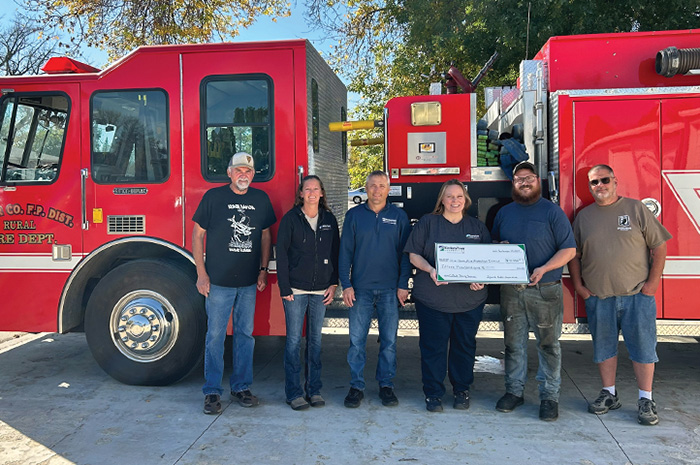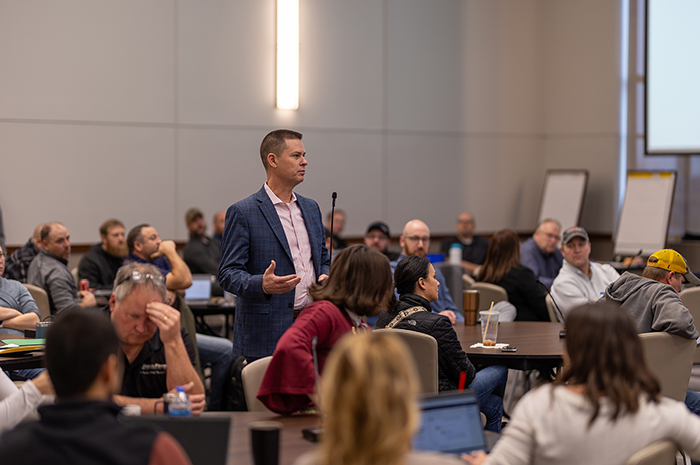Advocacy from afar
Virtual meetings have kept Minnkota engaged with lawmakers in advance of important legislative sessions.
The rural roadways of Minnesota and North Dakota are typically a second home for Stacey Dahl in an election year. The senior manager of external affairs dedicates those crucial fall months toward meeting with legislative candidates who may soon have the ability to shape Minnkota’s future.
With the COVID-19 pandemic limiting in-person meetings, Dahl’s windshield time was replaced with screen time in 2020. Dozens of virtual meetings were held with future policymakers in both states and on both sides of the aisle.
“It’s always nice to sit across the table from somebody and that’s what we would prefer to do going forward, but there is a lot of travel time involved,” Dahl said. “With a virtual meeting, we could connect with candidates in a pretty efficient way and still have a good, in-depth discussion. We’re really fortunate that technology facilitates that interaction.”
As the 2021 legislative sessions begin in January in Minnesota and North Dakota, virtual engagement will continue to be essential, as both states will utilize online formats for meetings and hearings. Addressing the effects of the COVID-19 pandemic and related budget shortfalls will be a focus throughout the sessions.
“Both states will be facilitating remote participation and that’s going to be a significant change from how these legislative bodies have operated previously,” Dahl said. “Minnesota has some experience in going remote partway through the session last year, but North Dakota has not been through this. It will certainly be an adjustment for most.”
Political engagement is embedded in the history of electric cooperatives. It has often been said that electric cooperatives were born in politics and if they die, they will die in politics. Over the years, Minnkota and its members have partnered with other electric cooperatives around the region to develop an effective grassroots political outreach program to ensure member voices are heard on important energy issues.
“We’re very sensitive to cost impacts from public policy,” Dahl said. “I think the takeaway from these discussions is a better understanding of who we are and why the cooperative model continues to serve us in this region very well.”
Promoting ECO Act in Minnesota
For Minnesota lawmakers, compromise will be the key strategy as their state has the only divided legislature in the country. The primary focus for electric cooperatives is encouraging passage of the Energy Conservation and Optimization (ECO) Act, which modernizes and reforms the state’s outdated Conservation Improvement Program (CIP). The CIP program does not recognize the benefits of efficient electrification of end-use processes, such as the adoption of electric vehicles and other emerging technologies. Conversely, the ECO Act emphasizes end-use total energy efficiency rather than narrowly focusing on reducing electricity use.
“We’ve talked about CIP reform for a long time,” Dahl said. “It’s a program that is in real need of modernization. We’ve done a lot of grassroots work to build support and we’ll make a strong push this session to get it passed.”
Electric cooperatives will be closely monitoring potential legislation that would require 100% of a utility’s generation portfolio to be carbon-free and other standards that would dictate that utilities must select carbon-free resources before any other resources.
Any decisions regarding the energy transition must include electric cooperatives and take into account technological capabilities, reliability and affordability.
Other focuses include addressing Department of Labor and Industry (DOLI) rules that require utilities to file a permit and be subject to inspection each time they replace a load control receiver, even though co-ops were not required to do so in the past. Load management allows utilities to reduce demand for electricity during peak usage times, which reduces the cost for consumers and provides environmental benefits. These additional costs may put those programs at risk.
Supporting North Dakota’s energy resources
Although the pandemic has created challenges in the near-term, the continued success of the lignite industry is vitally important to North Dakota because of its high-paying jobs, business activity and tax revenue. Besides the economic benefits, Minnkota and its members also receive affordable, reliable and increasingly clean electricity from lignite plants in the state.
Electric cooperatives will advocate for areas of state support, including policy changes and mechanisms to help control rising insurance costs.
“The cost of insurance has increased more than 30% in the last several years,” Dahl said. “At that trajectory, it amounts to a significant cost back to our membership.”
Continued support for the commercialization of carbon capture technology will also be pursued. Minnkota is currently evaluating Project Tundra – an effort to install carbon capture technology at the coal-based Milton R. Young Station near Center, N.D. If the project moves forward, it will be the largest carbon capture system on a power plant in the world.
“The state has played a crucial role in helping advance the research and development of carbon capture technologies,” Dahl said. “We believe the state’s support will continue to be important as these projects move toward commercial development.”
Main image: Brita Endrud (left), government affairs representative, meets virtually with Stacey Dahl, senior manager of external affairs. (Minnkota/Michael Hoeft)
...



